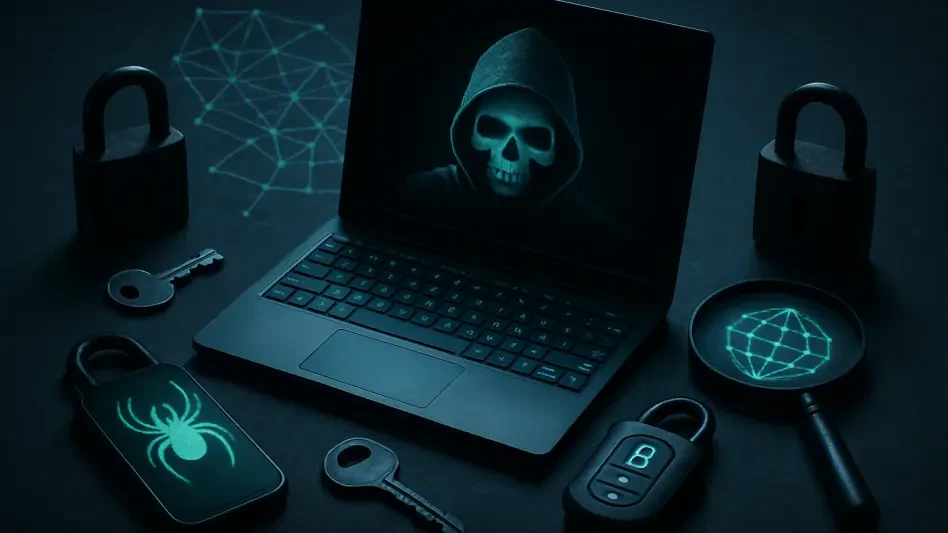In an era where digital breaches happen every day, the security of personal information has never been more crucial, with countless individuals falling victim to data leaks that expose emails, passwords, and even financial details to hidden online marketplaces. The dark web, a shadowy part of the internet, often becomes a hub for trading stolen data, leaving users vulnerable to identity theft and fraud. As hackers continue to exploit weaknesses in both personal accounts and corporate systems, the risk of sensitive information being sold to the highest bidder grows exponentially. Fortunately, a tool from a major tech provider offers a way to check if personal data has surfaced in these dangerous corners of the web. Known as the Dark Web Report, this feature provides a glimpse into whether specific details have been compromised. While it’s a step toward safeguarding privacy, questions remain about its scope and effectiveness. This article explores how this tool works, why it matters, and what steps can be taken if a breach is detected.
1. Understanding the Dark Web Report and Its Importance
The Dark Web Report is a free feature integrated into certain email services, designed to scan hidden online spaces for signs of leaked personal information such as email addresses, passwords, or even Social Security numbers. Users can set up a monitoring profile to receive alerts if their data appears in known breach databases or illicit marketplaces. This functionality acts as an early warning system, helping to identify potential risks before they escalate into serious issues like unauthorized account access or financial loss. While not a comprehensive solution, it serves as a starting point for those concerned about digital privacy. The tool’s primary value lies in its accessibility—requiring no additional cost or technical expertise to activate. However, its scans are limited to sources already indexed by the provider, meaning some threats may remain undetected. Despite this, the feature underscores a growing need for proactive measures in an age where data breaches are increasingly common.
The significance of monitoring dark web activity cannot be overstated, as these hidden platforms often serve as a breeding ground for criminal enterprises trading in stolen data. From personal credentials to corporate secrets, the information sold in these spaces can be weaponized for phishing scams, identity theft, or fraudulent transactions. With major breaches affecting millions of users each year, the likelihood of personal details ending up in the wrong hands is alarmingly high. The Dark Web Report offers a way to stay informed about such exposures, providing actionable alerts when matches are found. Yet, users must recognize that a clean scan does not guarantee safety, as not all corners of the dark web are accessible to the tool’s algorithms. This limitation highlights the importance of combining this feature with other security practices to build a robust defense against cyber threats. Awareness of these risks is the first step toward protecting sensitive information in a landscape riddled with vulnerabilities.
2. How to Set Up and Utilize the Scanning Tool
Activating the Dark Web Report is a straightforward process that can be completed in just a few steps through the associated account management settings. Users begin by navigating to the security section of their account, locating the dark web monitoring option, and selecting to start the process. From there, inputting specific details—such as a name, date of birth, multiple email addresses, and phone numbers—is required to create a monitoring profile. Verification of these details ensures accurate tracking, and once set up, the system begins scanning for matches in breach databases and hidden online sources. Results are categorized by data type, often accompanied by suggestions for next steps if a compromise is detected. While the setup is user-friendly, it’s worth noting that the tool’s effectiveness depends on the accuracy and completeness of the information provided during this initial phase, making attention to detail essential.
Beyond the initial setup, maximizing the utility of this scanning feature involves regular monitoring and complementary actions to enhance security. Once active, the tool provides periodic updates on any newly discovered exposures, allowing users to respond promptly to potential threats. However, relying solely on this feature is not advisable, as its coverage is not exhaustive. Pairing it with other independent scanning services can offer a broader view of potential risks, filling in gaps where the primary tool might fall short. Some users have reported quick detections of major breaches through this system, while others note occasional false positives from outdated data dumps that pose no current threat. To navigate such inconsistencies, cross-verifying alerts with additional resources ensures a clearer picture of actual risks. This multi-layered approach helps balance the tool’s benefits with its limitations, providing a more comprehensive strategy for safeguarding personal data against dark web threats.
3. Steps to Take If Data Is Compromised
Receiving an alert from the Dark Web Report indicating that personal data has been exposed demands immediate action to minimize potential damage. The first priority should be updating passwords for any compromised accounts, ensuring they are strong, unique, and ideally managed through a reputable password manager to avoid reuse across platforms. Enabling two-factor authentication on all accounts adds an extra layer of protection, making unauthorized access significantly harder even if credentials are stolen. These steps are critical in securing accounts and preventing further exploitation by cybercriminals. Additionally, reviewing account activity for unusual behavior can help identify if a breach has already been acted upon. Acting swiftly on these alerts can mean the difference between a minor inconvenience and a major security incident, emphasizing the importance of preparedness in today’s digital environment.
If more sensitive information, such as a phone number or financial data, is flagged, further protective measures are necessary to mitigate risks. Contacting the relevant service provider—whether a mobile carrier or a bank—to discuss options like account freezes or enhanced security protocols can prevent unauthorized transfers or transactions. Monitoring credit reports for suspicious activity is also advisable, as is placing a freeze on credit if there’s a risk of identity theft. For added certainty, running parallel checks with other breach notification services can confirm the extent of the exposure and uncover additional compromised data not detected by the initial scan. Auditing other accounts for reused credentials is another vital step, as many users inadvertently replicate login details across multiple platforms. Staying vigilant and proactive after an alert ensures that the impact of a data leak is contained, reducing the likelihood of long-term consequences.
4. Evaluating the Tool’s Value and Limitations
The Dark Web Report stands out as a valuable resource for users seeking to monitor their digital footprint at no additional cost, offering a basic level of protection against data leaks. Its integration into widely used email services makes it accessible to millions, providing early alerts that can prompt timely action against potential threats. High-profile breaches in recent years have demonstrated just how pervasive the issue of data exposure has become, and this tool reflects a broader push by tech companies to address user security concerns. For many, it serves as an entry point into understanding the risks of the dark web and the importance of staying informed about personal data breaches. While not a standalone solution, its simplicity and availability make it a worthwhile first step for those looking to enhance their online safety without investing in premium services.
However, the tool’s limitations must be acknowledged to avoid over-reliance on its capabilities. Its scanning scope is restricted to data sources already known to the provider, leaving some dark web activities undetected and potentially creating a false sense of security. Privacy trade-offs are another consideration, as users must share additional personal information to enable monitoring, raising questions about data handling practices. To counter these shortcomings, combining this feature with other security measures—such as strong passwords, multi-factor authentication, and routine checks with independent tools—is essential for a more comprehensive defense. The reality of constant cyber threats means that assuming exposure and acting preemptively is often the safest approach. Balancing the benefits of this free service with its constraints ensures users maintain a realistic perspective on their digital security.
5. Moving Forward with Enhanced Security
Looking back, the introduction of tools like the Dark Web Report marked a significant acknowledgment by tech giants of the escalating threats posed by data breaches in hidden online spaces. Alerts provided by such features helped countless users identify compromised information before it led to severe consequences like identity theft or financial fraud. The responses taken—ranging from password updates to enabling additional authentication layers—proved crucial in mitigating risks during a time when cybercrime was on a steep rise. Reflecting on these efforts, it became evident that while technology offered valuable assistance, the responsibility to act on alerts rested squarely with individuals. The past showed that awareness and prompt action were indispensable in navigating the complex landscape of digital security.
As a next step, users are encouraged to build on these lessons by adopting a proactive stance toward protecting their data. Exploring additional monitoring services to complement existing tools can provide a wider safety net against unseen threats. Strengthening personal security habits, such as regularly updating credentials and staying informed about emerging risks, remains a priority. Considering the evolving nature of cyber threats, investing time in understanding how hidden parts of the internet operate can further empower individuals to safeguard their information. By viewing features like the Dark Web Report as part of a broader strategy rather than a complete solution, a more resilient defense against data exposure can be established, ensuring greater peace of mind in an increasingly connected world.








